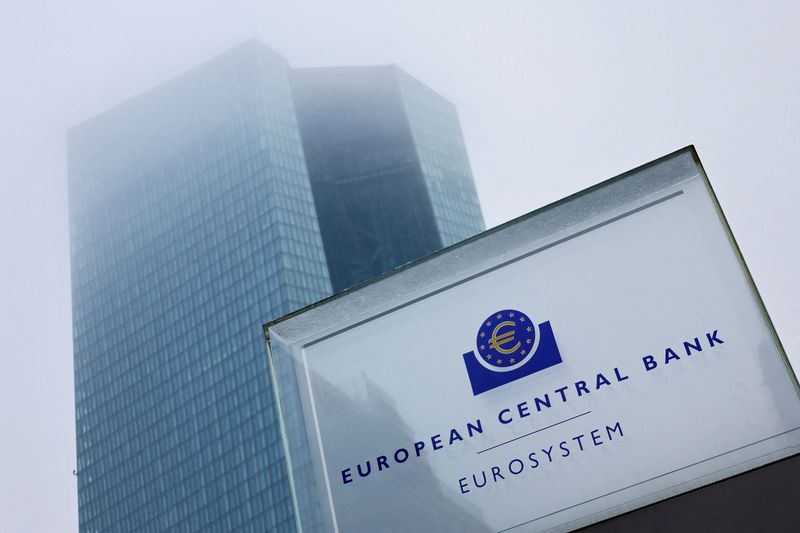By Yoruk Bahceli and Stefano Rebaudo
(Reuters) -Traders betting the European Central Bank is all but certain to start cutting interest rates in June just need a green light from policymakers on Thursday that the coast is clear.
Inflation slowed to even nearer the ECB's 2% target in March, paving the way for the bank to lead the U.S. Federal Reserve and other big peers in kicking off an easing cycle.
"Markets are looking for confirmation that a cut is coming in June," said Zurich Insurance Group's chief market strategist Guy Miller.
"If you don't deliver, then you risk roiling the market."
1/ IS A JUNE CUT A DONE DEAL?
Pretty much, given how many policymakers have signalled that as a likely start date for easing.
Even a hawk like Dutch central bank governor Klaas Knot says he's pencilled in June, while Austria's Robert Holzmann, seen as the leading hawk, is not opposed.
Frederik Ducrozet, head of macroeconomic research at Pictet Wealth Management, said the ECB wants to see data broadly in line with its expectations to deliver a cut, rather than needing to see improvements as the Fed has suggested.
"Even if you've got some upside surprises in one indicator, I don't think it would prevent them from cutting," he said.
One potential concern remains services inflation, which has held at 4% for months, reflecting relatively quick wage growth.
2/ WHAT WILL THE ECB SAY THIS WEEK?
It will likely signal rate cuts are coming. The question is how explicit it will be about June.
If the ECB opts for caution, it could say data is moving in the right direction for a cut, or it could signal a move conditional on the data it will see before June, analysts said.
Data last week showing inflation fell unexpectedly to 2.4% in March should give the ECB confidence after it lowered its inflation projections last month.
"Almost pre-announcing the rate cut could be what happens," said ING's global head of macro Carsten Brzeski.
Investors will also look out for any hints on the pace of the cutting cycle once it starts.
3/ WHAT DOES THE ECB NEED TO SEE IN UPCOMING WAGE DATA?
Policymakers want further signs of a slowdown after negotiated wage growth eased to 4.47% in the fourth quarter from a record 4.69% the previous quarter.
The ECB has singled out wages as the most important factor determining whether it can cut rates, so first quarter data due in May is a key reason why the ECB isn't seen moving on Thursday.
"I think the first cut in June will happen even if wages show only moderate improvement," said UBS's European chief economist Reinhard Cluse.
4/ WOULD A FURTHER SCALING BACK OF U.S. RATE CUT BETS CHANGE THE ECB OUTLOOK?
Not much. The euro zone economy is much weaker than its U.S. counterpart, so the ECB should be able to move first even if the Fed doesn't cut in June, analysts say.
The bigger question is if the Fed cuts a lot less than markets expect thereafter.
Traders no longer fully price the three rate cuts Fed policymakers anticipate, some analysts question whether U.S. rates will be cut at all this year.
Were the Fed to not cut rates this year, ING's Brzeski said he would expect two, rather than three ECB rate cuts given a potential inflationary impact of a fall in the euro that would likely result from the widening gap between U.S. and euro zone interest rates.
5/ HOW WORRYING ARE RISING OIL PRICES?
Not very.
Geopolitical tensions and expectations of higher demand pushed Brent crude prices to five-month highs over $90 last week, though they slipped on Monday on signs of easing tensions in the Middle East.
That's above the ECB's $79 a barrel forecast for 2024.
But current moves are "very small" compared to those seen after Russia's invasion of Ukraine and any resulting uptick in inflation should be temporary, said Berenberg economist Salomon Fiedler.

"They should not influence the ECB's policy path all that much," he added.
And natural gas prices, a key driver pushing inflation over 10% in 2022, have fallen since the start of the year.